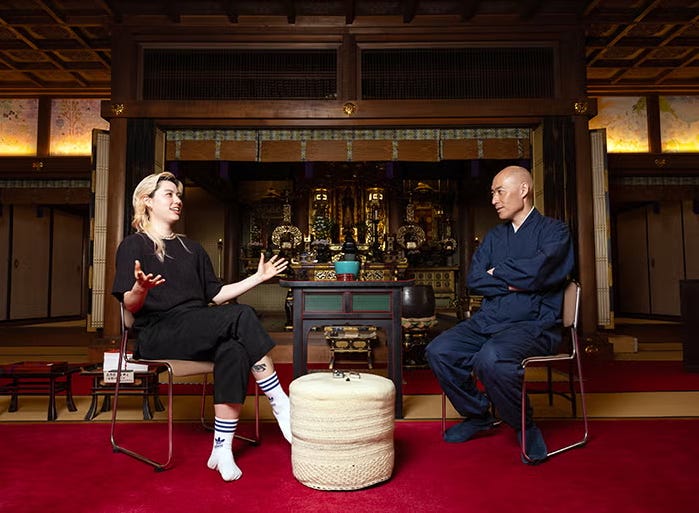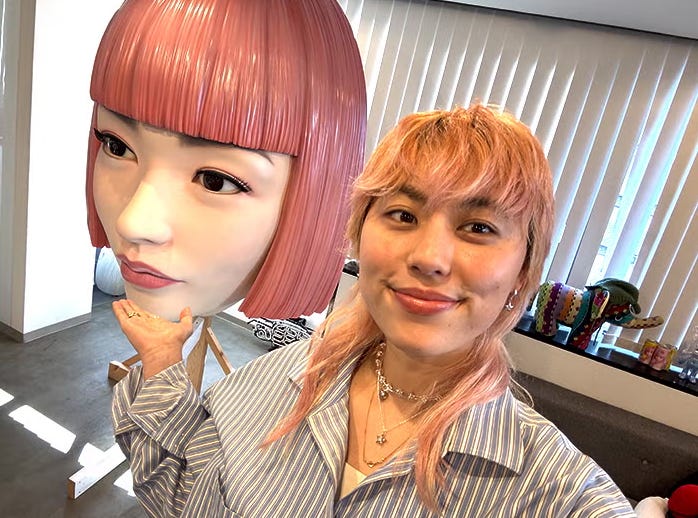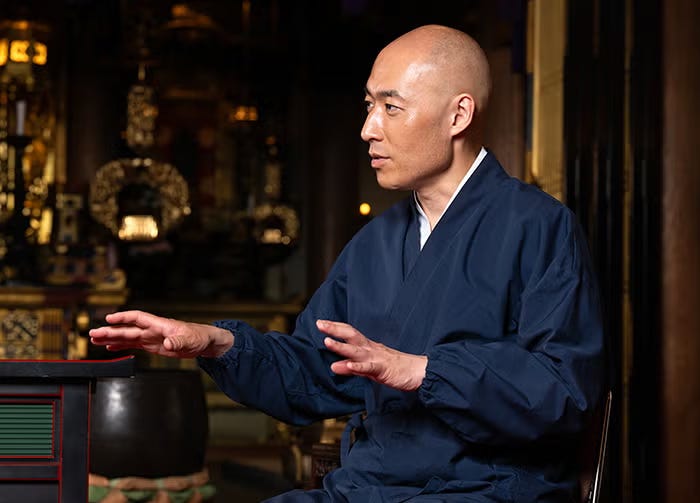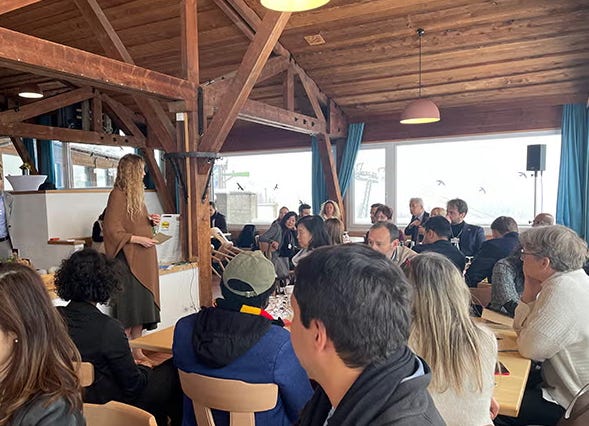Interbeing in the Age of Social Media: Virtual Human imma and the New Threads of Connection 〈1/3〉
Dialogue|Sara Giusto × Shoukei Matsumoto
Recently, I had the opportunity to engage in a dialogue with my friend Sara Giusto—creater and producer of virtual humans—as part of a serialized project by the Japanese media platform Sanga Shinsha.
We are living in an era where AI-generated creations move freely across boundaries, and the pace of this evolution shows no sign of slowing down. While many discussions are taking place around how we relate to AI, we must first ask ourselves: what do we mean when we say something is “real”?
Our conversation became a space for Sara to reflect on her own experiences, deepening this question further. At the same time, it led us into the heart of Buddhist thought.
This article is a translation of a paid feature originally published on Web Sanga Japan, shared here with the kind permission of its publisher, Sanga Shinsha.
Web Sanga Japan is an online media platform dedicated to Buddhism. Since its founding, it has explored Buddhist thought, philosophy, and practice from a wide range of perspectives, offering readers a bridge between Buddhism and daily life. It regularly features not only monks and Buddhist teachers but also individuals from various fields whose lives resonate with Buddhist values—shedding light on the many ways Buddhism is expressed in contemporary society.
From the philosophy of early Buddhism to present-day social issues and emerging technologies, Web Sanga Japan places no limits on how Buddhism can be approached.
Thanks to automatic browser translation features, the language barrier has become significantly lower. As a paid member of the online sangha, you will enjoy full access to all previously published articles (in Japanese). Readers of Sanga Japan form a gentle and inclusive “sangha”—a community of fellow learners exploring living Buddhism together.
(Originally published in Japanese on WEB Sanga Japan)
“Interbeing in the Age of Social Media: Virtual Human imma and the New Threads of Connection”
Sara Giusto × Shoukei Matsumoto
Hosted by Buddhist monk Shoukei Matsumoto—renowned for his work translating Buddhism into the language of the present day—this dialogue series features conversations with emerging leaders across diverse fields. In this installment, his guest is producer Sara Giusto, a pioneer in the creation of virtual humans.
Virtual humans are digital characters born through the cutting-edge use of 3DCG technology. They move through our era with appearances indistinguishable from real people. Among them is “imma”, one of the virtual humans produced by Giusto.
Though she lacks a physical body, imma nonetheless evokes a powerful sense of being alive—stirring the hearts of many today. How, then, might we redefine what it means to be “human”? And in what ways does imma’s existence resonate with Buddhist thought?
As the boundary between the real and the virtual continues to dissolve, this conversation delves into the evolving contours of human identity. Where do we find our sense of humanity in an era shaped by both technology and spirituality, by both the virtual and the real? Through this intersection, a new vision of “being human” begins to emerge.
Part 1
: New Storytelling in the Age of Social Media
Virtual Humans as Storytellers in the SNS Era
Shoukei:
To begin with, could you tell us about the virtual humans you work with, Sara?
Sara:
Sure. I’m Sara Giusto, the producer behind a virtual influencer named imma. imma is what we call a “virtual human”—she shares her daily life on social media platforms like Instagram, TikTok, and YouTube just like a real girl would. I work at a company that’s involved in everything from the initial concept and creation of imma to her production and content distribution.
The company is called Aww, a name taken from the English internet expression “aww,” which people use when something is cute or moving. We chose it because we want to create emotionally stirring virtual beings. As a producer, that’s the vision I’m working toward. Right now, Aww has around ten virtual humans bodies in total.
Shoukei:
So you count them by “bodies”. (laughs)
Sara:
Well, you could also count them as “people” I guess. (laughs) imma is our main character, but we’re also working on new avatars. Actually, imma has a younger brother, and he even has a girlfriend.
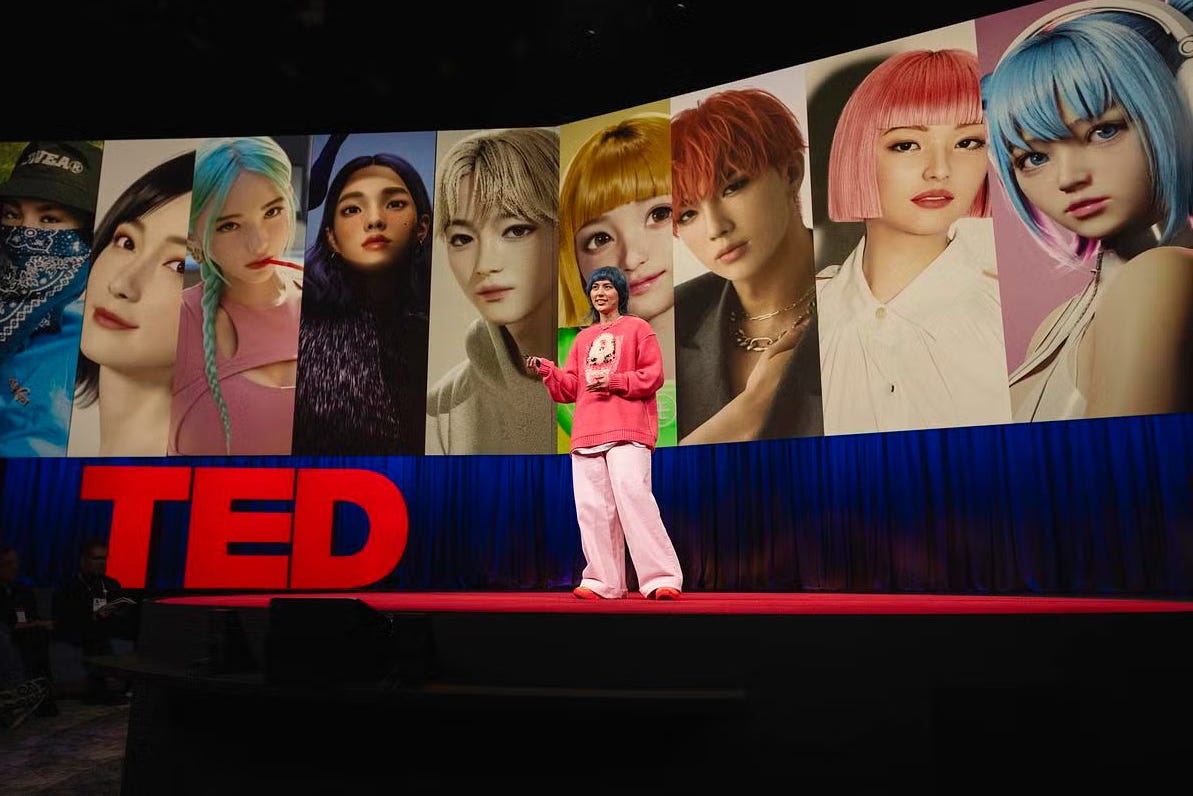
Shoukei:
Like Barbie’s extended family.
Sara:
Exactly. Her brother is really handsome, and we get a lot of DMs saying, “So hot♡” In fact, he gets more messages than imma.
Shoukei:
Interesting. Do you have any non-human characters, like a virtual dog?
Sara:
Yes, we do. But the dog imma owns is actually real. (laughs)
Shoukei:
Wait, the dog is real?
Sara:
Yes, it’s a real dog. It’s imma’s pet.
Shoukei:
Humankind has created an endless number of stories throughout history. Characters in manga or protagonists in novels could also be seen as a kind of virtual human. What makes yours different from those?
Sara:
Humanity has always excelled at portraying life through fiction. And the means of doing that have evolved with the times—starting with oral myths, then written texts, followed by animation as pioneered by people like Osamu Tezuka. Later, live-action media like film and photography emerged, and now we’ve reached the cutting edge with virtual technology.
Take Toy Story, for example—it was a groundbreaking film made through 3D modeling. Characters were sculpted digitally and animated like puppets. That was the new form of expression that Disney and Pixar introduced.
Then we asked, “What if we could do something like a movie on social media?” And that question gave birth to imma. Today, the main way we learn about other people’s lives is through SNS. When I see your Facebook post, I think, “Ah, so you’re doing well.” That post is storytelling. If you don’t post anything, I don’t know what’s going on in your life.
So why not use virtual humans as a tool for storytelling? That’s how it all started. It might sound complex when explained, but the core idea is actually very simple.
Is Social Media Fiction? Virtual Humans and the Feeling of Reality
Shoukei:
SNS has become the main platform for people to connect and maintain a sense of personal continuity. Into that space, you’ve introduced the new element of virtual humans.
Sara:
People generally think of social media as non-fiction, but to me, it feels more like fiction.
Shoukei:
From the Buddha’s perspective, maybe everything could be considered fiction. (laughs) But at least in theory, social media is meant to be a platform for sharing “real” experiences. So when something overtly constructed or “personalized” appears, like a virtual human, it seems to challenge that assumption.
Sara:
Right. To me, it feels totally natural, but people around me often tilt their heads and ask, “Why?” We cry at fictional movies, but because people assume SNS is based in reality, they get confused when a virtual human shows up.
Shoukei:
In Buddhism, we have Shakyamuni Buddha—the historical figure—and also many other Buddhas, like Amida Buddha, who is enshrined at temples like this one here at Komyoji in Kamiyacho. Amida Buddha didn’t actually exist in history; in that sense, you could say he’s a “fictional” Buddha. There’s long been a debate that we should return to Shakyamuni Buddha, the real person, and turn away from made-up Buddhas.
It’s true that as Buddhism evolved into Mahayana Buddhism, many “fictions” were introduced, and the teachings became more complex. That’s understandable. But when you think about it, Shakyamuni is no longer alive—we can’t meet him. In that sense, both Shakyamuni and Amida are “unreachable.”
Buddhism has invented various ways to address this issue: how can we encounter a Buddha we cannot meet?
If you prefer a historical figure, you focus on Shakyamuni Buddha. If that’s not important to you, there are other options like Amida(Amitābha) or Dainichi-Nyorai (Mahāvairocana). The form of Buddha you engage with is flexible, depending on your preferences.
The responses of those who prefer a historical figure like Shakyamuni Buddha and those who feel uneasy about a non-existent persona engaging on social media may, in some respects, overlap.
Sara:
That's really true. I find the attitude of “only believing in what exists” to be a bit anti-human. I think both the human brain and society are largely built on myths. The belief that truth and falsehood can be clearly separated in today’s information society is, to me, dangerous. Even the idea of “shared truth” is itself a kind of fiction, isn’t it?
People who insist on that dichotomy often become the harshest critics of imma. But I think everything is fake, and everything is real. In our company, we always say, “What you can believe in is the truth.” The point isn’t just to believe—it’s about being able to believe.
What moves you, what feels real to you—that’s what’s real. Something isn’t real just because it exists physically. It’s real because it stirs your emotions and resonates with you. That’s why it’s so important to create something that makes people believe. And for that, we have to be as creative as possible.
The people who give up on that creative effort are often the same ones who lazily declare, “This photo is fake.” But the truth is, humans are made of fantasy. It’s our shared fictions—like “we’re friends”—that help us coexist peacefully. Animals can’t do that. Of course, we are animals in a biological sense, but the reason we’ve come this far is precisely because of our power to imagine.
Part 2:
Virtual Humans and Japanese Animism
Humans as Beings Who 'Become' — Virtual Humans and the Japanese Spirit
Shoukei:
I see. In a way, the concept of virtual humans might be more aligned with Mahayana Buddhism.
Sara:
To me, imma is essentially a form of idol worship in the age of social media. I truly believe there’s no better way to describe her.
Shoukei:
That reminds me of the mindset of a Buddhist monk. Becoming a monk means letting go of your previous identity—changing your name, your clothing, and deliberately choosing to become impersonal. Of course, these days monks themselves can appear quite unique, but within the community of monks, everyone looks so similar it’s almost impossible to tell them apart.
It’s a kind of virtualization of the self—a voluntary shedding of individual personality. I think that’s one reason I’m drawn to the idea of virtual humans: I see in them a resemblance to the monastic way of being.
Sara:
I fundamentally believe that humans have always desired avatars. Just look at the British Museum—it's full of masks. I don’t see those as mere decorations; I interpret them as mediums for conveying stories. Your appearance, Matsumoto-san, and mine as well—we are each a kind of “embodied narrative.”
We use these forms to find common ground—or sometimes lose it—with others. I often think about this primal human desire to “become something,” to wear a mask.
From a Buddhist perspective, our very form is already an avatar. All of us are customizing our bodies and appearances as a form of self-expression. Even paintings and temple architecture are aesthetic expressions. I think VTubers, avatars, and virtual humans are simply the evolutionary extension of that.
Shoukei:
You could say that making your SNS profile sparkle is also a form of avatar creation.
Sara:
Absolutely. Japanese people tend not to post their real names or photos online. That’s in stark contrast to places like the U.S. and Europe, where real-name platforms like LinkedIn dominate. I think this cultural trait is deeply connected to the rise of anime culture in Japan.
There’s a preference for anonymity here. Japanese people don’t necessarily tie their physical appearance to their identity. This unique sensibility might be influenced by an animistic worldview that’s been around since ancient times. In that sense, I find it really fascinating that a character like imma could be born from this kind of cultural soil.
Shoukei:
That makes sense. Come to think of it, my profile on X (formerly Twitter) uses an illustration of someone cleaning, not a photo of myself.
Sara:
Actually, Japan is the largest market for X in terms of user numbers. In other countries, especially in the West, X tends to attract more niche or tech-focused users. As for me, I’m not really into X because its focus on text and minimal icons doesn’t fit my personality. I prefer to use my real name and age on my profile and express myself more visually, so I naturally gravitate toward platforms like Instagram.
I believe there’s a religious and cultural background to the Japanese tendency toward “detachment from the physical body and appearance.”
The idea of “Yaoyorozu no Kami”—the belief that gods dwell in stones, mountains, and other non-living things—resonates with the way people accept characters like imma.
Because of this cultural background, when imma appears in ads, Japanese people just naturally say “So cute ♡” and embrace her.
But overseas, the reaction is often more like, “What is this?! It’s a threat to humanity!” Behind that contrast may lie fundamental differences in worldviews—especially religious foundations. In the monotheistic traditions of the West, perhaps it’s harder for such character-like beings to emerge and be accepted.
Beyond Anthropocentrism
Shoukei:
I attended the Davos Conference again this year, and one of the most interesting sessions was a closed retreat titled Climate and Nature Retreat. It wasn’t some conspiracy—it really was a sincere discussion about the environment.
But the format was quite unique: we left the main conference site, took buses and gondolas, and held the session in a snowy mountain lodge.
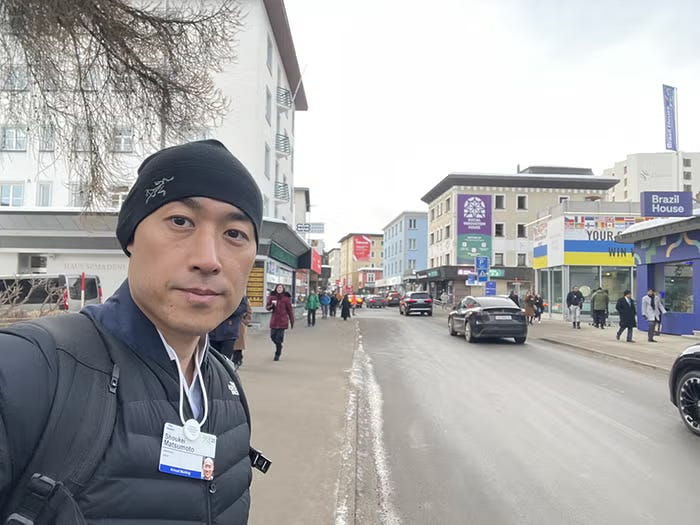
Nicole, one of the facilitators, posed a thought-provoking question: “If we were to invite non-human beings into this conversation, who would we invite?
Right before that session, I had been speaking with Audrey Tang in Taiwan—she’s a nomadic thinker and one of my heroes—so I was already in a certain frame of mind.
I said, “Since I’m in Davos today, I’ll invite that tree I can see from this window.” Nicole responded, “Great. Then please become that tree and define what ‘private value’ means to you.” It may have been a small gesture, but to me it marked an important turning point.
In the West, people quickly use the term “humanity,” but the word itself contains a philosophical bias toward anthropocentrism. Even concepts like inclusivity or sustainability still center humans. Ideas like “Let’s include animals and plants” are steps forward, but they still take the human perspective as the norm.
I think the emergence of AI is telling us: it’s time to seriously move beyond this human-centered worldview. We need to shift toward a pluralistic perspective—one where multiple kinds of beings each have their own valid viewpoint and together compose the world. Many thinkers today believe that Japan, with its refined tradition of animism, can serve as a reference point for this kind of paradigm shift.
Sara:
I was born in Japan, but I spent ten years—through elementary, middle, and high school—in Canada and the U.S., so I came back as a returnee. At first, I couldn’t understand the animistic mindset at all. I had a very human-centric way of thinking. For the first two years after returning to Japan, I was actually quite frustrated by the cultural differences.
But now, in my 11th year back, I’ve come to feel that Japanese daily life is infused with a kind of animistic communication—not everything is about winning or losing, and people don’t limit their interactions to just other humans. Maybe not the elites at the top of capitalism, but in ordinary communities, there’s a deeply ingrained spirit of mutual care. Even at a family restaurant, when a robot brings your food, Japanese people naturally say, “So cute ♡ Thank you!” It’s like they’re already wired to coexist with something like Doraemon.
And I’ve always wondered: Why are we supposed to fight against AI? Sure, maybe we need to if we want to maintain human superiority, but honestly—did such superiority ever really exist in the first place?
to be continued to the Part 3.


